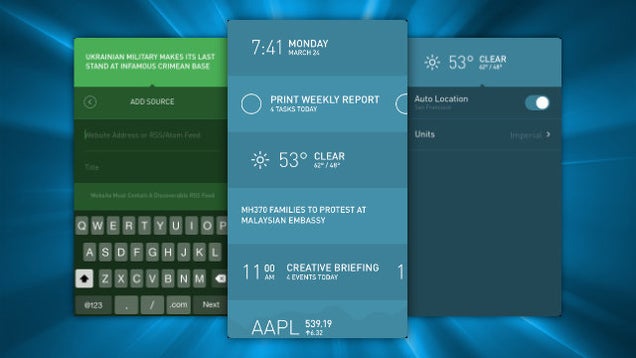Let’s take a quick look at the two companies’ flagship offerings. On one side, we have the recently-released Samsung Galaxy S5, a welcome refresh to the Korean firm’s flagship series. On the other, we have Apple’s iPhone 5S, which is about six months old, but still going strong in terms of sales and activations for the Cupertino, CA-based company.

The two flagship devices are very powerful, although there are marked differences in philosophy, in terms of design and architecture. Many would consider the upgrades to be incremental over their predecessors, however, at least from the outside. Much of what has changed in the Galaxy S5 and iPhone 5S are in their respective specs and user interfaces.
Here’s a more in-depth look at the Samsung Galaxy S5 vs the iPhone 5S!
Design and Build Quality

In terms of physical construction, Apple follows the same philosophy with every “S” release of the iPhone. The 5S looks similar to its predecessor, except for the addition of the fingerprint scanner on the home button and the new dual-LED flash beside the camera. The home button now gets the chrome treatment and is markedly different from the recessed design of previous iPhones (as well as the current 5C). It may not have changed at all, but the aluminum unibody design still evokes that premium feel that you get with most Apple products.

The Galaxy S5 retains the form factor of its predecessor, although the specs have certainly been bumped up. Noticeable are the addition of the fingerprint scanner, which is integrated into the home button, as well as the new recent apps/multitasking key, which replaces the capacitive menu button. The back plate now features a perforated soft-touch plastic design, the reactions to which have certainly been mixed, but is still a necessary move away from the glossy plastic found with previous iterations.
Comparing the two in terms of form factor is obviously like comparing apples to oranges (or “Apples” to “Galaxies”?) because of size. The Galaxy S5 delivers a lot more screen real estate, but the iPhone 5S has a more compact and pocketable design and offers a much better one-handed handling experience. Preference of design elements and size is certainly subjective, so it really comes down to what you’re looking for in this regard.
Display

Again, the size difference might mean an inconsistent screen comparison. With a large difference between the 5.1-inch screen of the Samsung Galaxy S5 and the 4-inch display of the iPhone 5S, each device is clearly aimed at different users. However, in terms of the display quality, there are marked differences.
The iPhone 5S’ screen has been praised by experts for its accurate color reproduction, brightness and superior viewing angles. However, it uses the same screen as its predecessor, with an 1136 x 640 px Retina display, resulting in a 336 PPI pixel density. This might disappoint those who expected a screen upgrade from the iPhone 5.

The Galaxy S5′s use of Super AMOLED results in very distinct blacks and vivid colors, and the higher 432 PPI on its 1080P display makes for crisper images. Of course, the clear benefit here is that the much larger surface accommodates more on-screen real estate, which will be useful for media consumption like reading, playing games, and watching videos.
Given that smartphone usage nowadays favors increased multimedia consumption, the larger screen is clearly an advantage. The iPhone 5S may offer better accessibility and pocketability with its compact design, but once you experience a bigger screen, you might not want to go back to using a smaller phone. A larger screen is much more fun.
Performance

Again, we’re dealing with two different philosophies when it comes to performance, so a straight-up specs comparison doesn’t really do either phone any justice. Because the Galaxy S5 and the iPhone 5S live in different ecosystems, we’ll consider real-world performance in our comparison.
iOS focuses on fluid animations and impressive optimization. The interface was greatly revised with the introduction of iOS 7, and Apple has already dealt with glitches and bugs that were found with an update to iOS 7.1. Performance was never in doubt, and the iPhone 5S can sail through most tasks you would throw at it. The 5S’ new 64-bit processor is a significant upgrade over its predecessor’s, which gives it an edge in terms of computational speed, as well as more capable use of its RAM.

The Galaxy S5, meanwhile, sports a 2.5 GHz quad-core Snapdragon 801 processor, which is likewise a huge increase over previous models. Backed by an Adreno 330 GPU and 2 GB of RAM, the S5 is clearly one of the most powerful Android device in the market. You will rarely see any lags and stutters that may have plagued previous models in the S series, particularly with Samsung’s use of resource-heavy TouchWiz (more on this later).
Suffice to say that both the Galaxy S5 and iPhone 5S are great performers, and should satisfy even power users who want the most out of their devices.
Hardware

In terms of hardware design and features, Samsung may be the clear winner here, having put in a host of bells and whistles on the Galaxy S5. While the iPhone 5S also has a fingerprint scanner, the Galaxy S5 also features a heart rate monitor, which will come in handy for health enthusiasts. The S5 also has NFC support, a microSD slot for storage expansion, an IR blaster and comes with a removable/replaceable battery. In addition, IP67 certification means wear and tear will be kept at a minimum, with the Galaxy S5 being dust- and water-resistant to some extent.
While the iPhone 5S offers less in terms of hardware features compared to the Galaxy S5, having it all might not necessarily make a device the best one. The iPhone 5S does offer a more polished user experience. The verdict here will boil down to how useful you find the extra features on the Galaxy S5.

The fingerprint scanners on both devices are a welcome addition, providing an added layer of security that will come in handy for phone unlocking and, in particular, financial transactions. The two differ in operation, though, with the Galaxy S5′s mechanism requiring a swiping gesture, while the iPhone 5S only requiring the user to touch to scan.
While applications of the fingerprint scanners are limited at this time, the potential is quite great, especially considering wallet and mobile payment functionalities.
Battery

We might initially find the iPhone 5S’ 1,560 mAh battery as meager. However, with Apple’s optimizations, we found that we were able to squeeze out more than a day’s worth of power with moderate use. In real world scenarios, however, we personally know a handful of iPhone users who frequently find the need to recharge their devices in the middle of the day, so it really depends on usage.
The Galaxy S5 comes with a 2,800 mAh battery that provides excellent battery life, which can be further extended through various power-saving modes built into the smartphone’s OS. This includes an ultra saving mode that strips down the UI to a greyscale barebones version. And because Samsung’s batteries are removable, you can always carry a spare battery for those long trips away from a charger.
In terms of hardware, the Galaxy S5 does try to do everything at once. Of course, it depends on the kind of experience you want with your smartphone. If you want all the tools, bells and whistles, the Galaxy S5 is the one for you. Meanwhile, the iPhone 5S is a what-you-see-is-what-you-get affair, yet offering a perfectly good user experience if simplicity is your thing.
Camera

It’s a bit of a close call when it comes to the camera, with both devices offering their respective strengths. Samsung’s use of a 16-megapixel ISOCELL camera shows that it’s serious in providing the best smartphone camera experience, with the use of ISOCELL resulting in vivid photos. Samsung did away with the sheer amount of camera app features found on the Galaxy S4. Instead, Samsung added a couple of key features, particularly Live HDR and Selective Focus.
Google may have pre-empted Samsung’s inclusion of selective focus with its Lens Blur feature in the stock Google Camera app. Still, Samsung’s implementation does produce great quality pictures, although it can be hit-and-miss at times. Diving deeper into the camera app’s options will give you a world of options that can suit any smartphone photography need.
Image quality is good, and even zooming into photos will reveal a certain sharpness and level of detail. Low-light photography has improved, but you still get some graininess in these scenarios — something expected from smartphone cameras.

As for Apple, the 8-megapixel iSight camera is well-acclaimed. And even if it lacks in sheer number of features compared with the S5′s camera and app implementation, the iPhone 5S’ camera does come with interesting features, including Auto HDR. While the lack of options in the iPhone 5S’ camera may be its greatest weakness, the resulting images are usually very good in any case.
If you’re out to tweak and customize your smartphone camera experience, then the Galaxy S5 is the phone for you. Otherwise, if you’re the type to set-and-forget, then the iPhone 5S’ camera may be the best choice. Overall, however, both cameras are at par with each other. The Galaxy S5 provides one of the best Android camera experiences, while Apple upholds its tradition of fine smartphone camera optics.
Software

Apple revamped its user interface with the introduction of iOS 7 in 2013, which did away with the old skeumorphic design in favor of a flatter, brighter and more abstract interface. The UI is markedly simplistic, although the iPhone is responsive and reliable, which many an iPhone user can attest to. iOS 7 is definitely cleaner, sleeker and brighter than Apple’s previous releases.
A welcome addition in iOS7 is the Control Center, which can be accessed by swiping up from the bottom of the screen. This provides easy access to brightness, the music player, shortcuts to commonly-used apps like the calculator and torch, and connectivity toggles. iOS7 also gives better control over the notification center. Overall, however, iOS does provide a lower level of customization, which might be frustrating for those used to tweaking and customizing their user interfaces.

Samsung’s TouchWiz UI has also undergone some changes in the Galaxy S5, although it’s not as drastic as Apple’s design change. Overall, TouchWiz still looks and feels the same, with a few changes in the UI and on-screen elements. For one, Multi Window makes a return to TouchWiz. The floating Toolbox and Download Booster are welcome additions.
Those familiar with TouchWiz will feel right at home with the Galaxy S5, although there are some subtle changes, including a new circle motif in the Settings app and notification center. Also, the MyMagazine UI is now a second screen located towards the left of the home screen, easily accessible with a swipe. MyMagazine offers a gateway to one’s social media feeds, although it actually piggybacks off Flipboard, which is already a powerful newsreader app available for both Android and iOS platforms.
As with most upgrades, however, we feel that the new additions — both software and hardware — will tend to quickly lose their shine. We think of this as the “Galaxy Syndrome”, a term you may have heard us use before. However, the same may be said for the iPhone. Even with the interface changes, the functionality and user experience is still basically the same.
Specs Comparison
| Samsung Galaxy S5 | iPhone 5S | |
|---|---|---|
| Display | 5.1-inch Super AMOLED, Full HD (1920 x 1080), 432 ppi | 4-inch IPS LCD, 1136 x 640, 326 ppi |
| Processor | 2.5 Ghz quad-core Qualcomm Snapdragon 800 | 1.3 Ghz dual-core Apple A7, PowerVR G6430 GPU |
| RAM | 2 GB | 1 GB |
| Cameras | 16 MP rear LED flash, 2.1 MP front | 8 MP rear dual-LED flash, 1.2 MP front |
| Battery | 2,800 mAh | 1,560 mAh |
| Storage | 16/32 GB, expandable | 16/32/64 GB |
| Networks | 3G, LTE Cat. 3 2X2 MIMO | 4G LTE - all |
| Connectivity | GPS, GLONASS, microUSB 3.0, Wi-Fi a/b/g/n, Bluetooth 4.0 LE | GPS, USB 2.0, Wi-Fi a/b/g/n, Bluetooth 4.0 |
| Software | Android 4.4 Kitkat | iOS 7 |
| Dimensions | 142 x 72.5 x 8.1 mm, 145 grams | 123.8 x 58.6 x 7.6 mm, 112 grams |
Final Thoughts

The two flagship phones represent their respective brands, ecosystems and companies quite well. The differences in form factor and ecosystem will mean that the choice between the Samsung Galaxy S5 and Apple iPhone 5S will be a subjective one. Here’s a quick recap:
Samsung Galaxy S5. Samsung’s latest flagship offers a bigger Super AMOLED screen, twice the megapixel count, twice the battery capacity and better resistance to the elements through its IP67 rating. The S5 is clearly one of the most powerful Android devices to date, and it does offer a high level of customizability, characteristic of this particular ecosystem. Between the two smartphones we compared here, the S5 is the multitasking powerhouse — a feature-heavy phone that gives you power and customizability out of the box.
Apple iPhone 5S. Apple’s latest flagship is a more accessible device due to its compact size. It offers a polished user experience and classy design that you can expect from Apple. Even with lower specs on paper, Apple has clearly optimized the iPhone 5S to take advantage of the 64-bit architecture, resulting in a fast and reliable user interface, decent battery life, and a phone that “just works.” If you want something simple and straightforward, or if you’re already deeply invested into the Apple ecosystem, then the iPhone 5S is the right device for you.
Of course, these are not the only flagship devices out there. You may wish to consider the likes of the HTC One (M8), Sony Xperia Z2 and we’ve compared the Sony Xperia Z2 with the Samsung Galaxy S5, too. In terms of price, however, you will find the iPhone 5S being offered at lower in-contract prices with most carriers, as it has already been in the market for a few months now.
You should still get a lot done on either the Galaxy S5 or the iPhone 5S, whether in terms of work or play. It’s a matter of choice and user preference.











 He was originally recruited for the CMO position, having served as CMO and, more briefly, CTO, at both Overstock.com and ChaCha. However, after hearing about the situation, Schwegman said he’d only take the CEO job if available, warning them that they pivot the company entirely, dump the code, launch a new, mobile-first product, and change the name.
He was originally recruited for the CMO position, having served as CMO and, more briefly, CTO, at both Overstock.com and ChaCha. However, after hearing about the situation, Schwegman said he’d only take the CEO job if available, warning them that they pivot the company entirely, dump the code, launch a new, mobile-first product, and change the name. As for the email client itself, it’s fairly impressive for such a young product. The app mimics the default Apple Mail app’s look and feel, with the same font, spacing, the little blue dots indicating unread messages, the bottom-right “Compose” button, swipe-to-archive gestures, and more - all which makes Gusto feel less foreign.
As for the email client itself, it’s fairly impressive for such a young product. The app mimics the default Apple Mail app’s look and feel, with the same font, spacing, the little blue dots indicating unread messages, the bottom-right “Compose” button, swipe-to-archive gestures, and more - all which makes Gusto feel less foreign. Some of the features Gusto offers are more similar to certain other email apps like Mailbox, which focuses on fast search and integrations with cloud services, too, or Acompli, which also breaks out files into their own dedicated sections, among other things.
Some of the features Gusto offers are more similar to certain other email apps like Mailbox, which focuses on fast search and integrations with cloud services, too, or Acompli, which also breaks out files into their own dedicated sections, among other things.














 © Samsung/Apple/AndroidPIT
© Samsung/Apple/AndroidPIT Samsung is faithful to the plastic, yet wanted to change the design slightly and add another type of texture. / © AndroidPIT
Samsung is faithful to the plastic, yet wanted to change the design slightly and add another type of texture. / © AndroidPIT The screen of the S5 is one of the brightest in the market. / © AndroidPIT
The screen of the S5 is one of the brightest in the market. / © AndroidPIT The iPhone 5S features a dual flash. / © Apple
The iPhone 5S features a dual flash. / © Apple The Galaxy S5 settings menu © AndroidPIT
The Galaxy S5 settings menu © AndroidPIT On the left, the iOS Control Center, and on the right, the Samsung Quick Settings. / © AndroidPIT
On the left, the iOS Control Center, and on the right, the Samsung Quick Settings. / © AndroidPIT The iPhone 5s was the first Apple phone to incorporate a fingerprint sensor. / © Apple
The iPhone 5s was the first Apple phone to incorporate a fingerprint sensor. / © Apple  Samsung has also added a fingerprint scanner in your Home button © AndroidPIT
Samsung has also added a fingerprint scanner in your Home button © AndroidPIT









